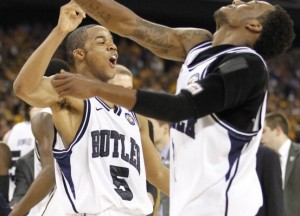NCAA Mid-Major Success: Is It An Age Thing?
With Butler playing for the national championship for the second straight year, having defeated VCU in the Final Four, everyone’s debating the reasons behind the recent success of mid-major teams in the NCAA Tournament. Evidence abounds:
- Since George Mason went in 2006, four of the last six Final Fours have included a team from a mid-major conference— defined as any Division I athletic conference outside of the six “majors”: The ACC, Big East, Big Ten, Big 12, Pac-10, and SEC. These conferences bring in the bulk of college athletic money, mostly through TV contracts. The current value of their six combined TV contracts is about $683 million.
- Butler’s showdown with VCU was only the second time since 1979 that two mid-major teams made it to the same Final Four. The last time was 1979, when Penn and Indiana State (behind Larry Bird) made it.
- Butler’s conference, the Horizon League, has put a team into the second round of the NCAA Tournament in each of the past six years, and ten of the last 13.
The most interesting view I’ve heard on why this is happening comes from Jay Bilas over at ESPN, who in this video argues that it’s not so much that mid-majors have suddenly gotten better, but that the “majors” have gotten worse. Bilas blames this on the “talent drain” of top college players leaving early for the NBA that’s been happening increasingly since 1995, the year that Kevin Garnett became the first high-school basketball player drafted since Moses Malone in 1975.
So, do major conference teams have younger rosters? Let’s take a look. Here’s a breakdown of the seven players who saw the most minutes on each team during this year’s Final Four:
VCU: 4 Seniors; 2 Juniors; 1 Sophomore; 0 Freshman
Butler: 2 Seniors, 2 Juniors, 2 Sophomores, 1 Freshman
Kentucky: 1 Senior; 3 Juniors; 0 Sophomores; 3 Freshmen
UConn: 1 Senior; 1 Junior; 2 Sophomores; 3 Freshmen
Clearly, UConn and Kentucky, the two teams from major conferences, have the younger rosters, with six freshmen and just two seniors between them, compared with just one freshman and six seniors between Butler and VCU.


Comments